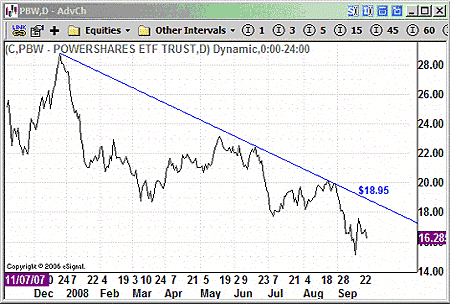An easier way to invest in wind
With high fuel prices and worries over energy security and climate change, alternative energy is on the up. But how do you choose which companies to invest in? Put your money into ETFs, and you get good exposure to a basket of stocks.
With the steady climb of oil prices over the past few years, it's become apparent that higher prices are here to stay.
As a result, the market has spawned dozens of new alternative energy stocks - and subsequently, ETFs devoted to the sector.
However, with alternative energy technology developing rapidly and sub-sectors like wind, solar, geothermal, bio-fuels, and bio-mass all springing into the headlines, it can be tough to know which stocks or ETFs an investor should play.
MoneyWeek
Subscribe to MoneyWeek today and get your first six magazine issues absolutely FREE

Sign up to Money Morning
Don't miss the latest investment and personal finances news, market analysis, plus money-saving tips with our free twice-daily newsletter
Don't miss the latest investment and personal finances news, market analysis, plus money-saving tips with our free twice-daily newsletter
Fortunately, ETFs give you broad exposure and diversity to certain markets, with less risk than owning individual stocks.
For example, the two most widely followed alternative energy ETFs are the PowerShares WilderHill Clean Energy ETF (AMEX:PBW), which is mostly made up of American companies, and the Market Vectors Global Alternative Energy ETF Trust (NYSE:GEX), which gives you international exposure to some of the largest companies dealing in wind power.
In 2007, these ETFs turned in outstanding performances, chalking up gains of 62% and 50% respectively. And GEX may have done even better, due to the fact that it did not begin trading until May 2007.
In 2008, however, the funds haven't been able to sustain that performance. As of September 26, PBW is down about 40% for the year, while GEX has lost 25%.
Alternative energy stocks: 'Springing' back to PBW
Back in the spring (March 24, to be exact), I highlighted the performance of PBW in my "Sector Watch" piece. At the time, the stock was trading around $21 and had recently tested its January lows. With the chart pattern still bearish, I said it represented a good short-selling opportunity.
Before it rebounded last week, PBW had traded below $15. But as long as oil prices remain high, ETFs like PBW should come back into favor. Moreover, after the beating they've taken this year, they look like good value.
That said, I don't like trying to pick bottoms, so let's take a look at the daily chart of PBW for more clues

As you can see, the downtrend line drawn from the highs last December currently sits at $18.95. As time goes by, this number will go lower, but a couple of closing prices above this downtrend line will signal a change in trend - and that the stock is probably worth buying.
Alternative energy stocks: Profits from thin air
Between PBW and GEX, though, I actually prefer GEX, due to its higher exposure to the wind power segment. This fast-growing area is gaining some serious momentum and greater investment, thanks to the publicity that T. Boone Pickens is bringing. Pickens is a very smart businessman, who is investing billions towards the largest 'wind farm' in the US And you can see why he's on board
Wind power is the second largest source of new power generation in the US, surpassed only by natural gas.
In 2007, wind provided enough power to satisfy the residential electricity needs of 150 million people.
Capacity increased by a record-breaking 20,000 megawatts, which puts the world total at 94,100 megawatts.
According to the US Department of Energy, since 1980, the cost of producing wind power has declined by as much as 90%.
Electricity from new wind power projects will be cheaper than electricity from new conventional power plants by 2010.
If you're a fan of wind power, there is a relatively new ETF that deals strictly with the field. It's called First Trust ISE Global Wind Energy (NYSE:FAN) and it began trading in June 2008.
Having hit a high of $31.50 in June, FAN has sold off, along with the other alternative energy ETFs. Earlier this month, it traded as low as $20, so let's take a look at the chart to see what the next move might be

With only a few months of data to go on, projecting the stock's next move is a little trickier, but we have enough information to draw a regression channel from the June highs. The upper band of the channel is currently around $24.15 and a couple of closes above that level should lead to higher prices for the stock.
We'll keep an eye on this one, as wind power continues to gain traction.
This article was written by Jim Stanton for the Smart Profits Report
Get the latest financial news, insights and expert analysis from our award-winning MoneyWeek team, to help you understand what really matters when it comes to your finances.
MoneyWeek is written by a team of experienced and award-winning journalists, plus expert columnists. As well as daily digital news and features, MoneyWeek also publishes a weekly magazine, covering investing and personal finance. From share tips, pensions, gold to practical investment tips - we provide a round-up to help you make money and keep it.
-
 Pundits had a bad 2025 – here's what it means for investors
Pundits had a bad 2025 – here's what it means for investorsThe pundits came in for many shocks in 2025, says Max King. Here is what they should learn from them
-
 The MoneyWeek ETF portfolio – early 2026 update
The MoneyWeek ETF portfolio – early 2026 updateThe MoneyWeek ETF portfolio had a solid year in 2025 and looks well placed for what the next 12 months may bring

